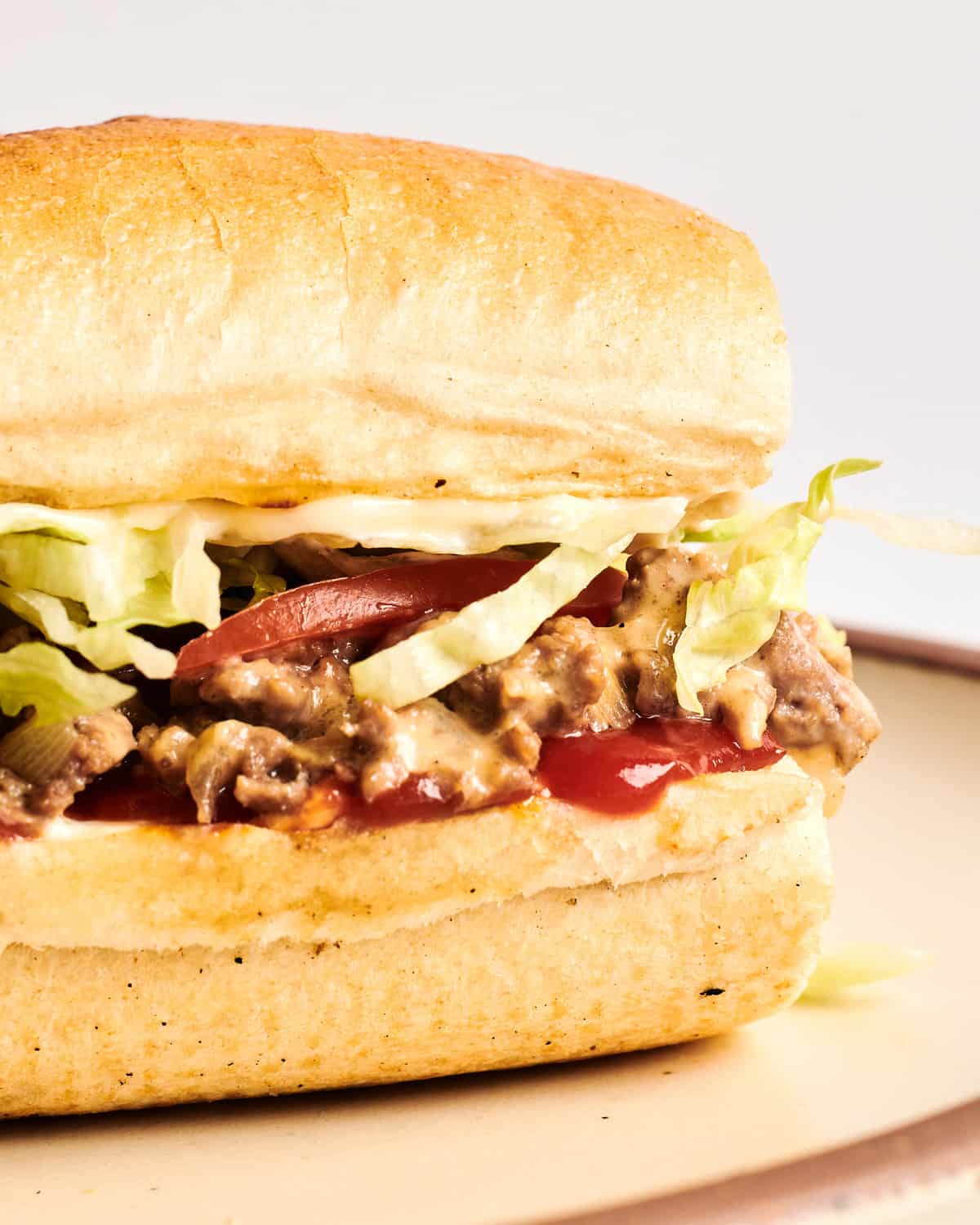How to Safely Lose 2 Pounds a Week, One of the Most Common New Year's Resolutions
These tips can help you shed lbs safely and effectively.


Travis Rathbone
As a personal trainer, one of the most common questions I get around the new year is: How do I lose two pounds a week? Some people swear by steady-state cardio workouts to burn fat fast, while others rely on HIIT or hybrid workouts like Hyrox. But the reality is if you want to learn how to lose two pounds a week (a sustainable rate for most people in the beginning of a weight-loss journey) you'll have to stick to a methodical weight-loss workout plan and weight-loss diet plan.
While most people want quick fixes, it's much better to lose weight at a slow and steady rate. By doing so, you'll keep your physical and mental health in check and avoid common signs of diet fatigue like poor training, ravenous cravings, and trouble sleeping.
Note: Even with this blueprint on how to lose two pounds a week, it might not happen easily, or at all, despite your best efforts. Your metabolism, sleep, workout routine, and macro-tracking methods can impact how close you get to your goal, research indicates. But there are ways you can set yourself up for the best chances of losing weight and reaching your goal.
How Many Calories Are in Two Pounds of Fat?
If you've decided to lose weight, one of the first things to nail down is your rate of weight loss or how much you'll aim to lose each week to meet a final weight-loss goal. There are 7,000 calories in two pounds of fat, so to lose two pounds a week, you'd plan for a calorie deficit of 1,000 calories per day. However, this isn't safe or ideal for everyone.
How to Determine What Your Calorie Deficit Should Be
Losing two pounds a week means cutting 1,000 calories per day from your maintenance level of calories. The U.S. National Institutes of Health recommends a daily calorie deficit of 500 to 1,000 calories for safe weight loss of about one to two pounds per week for overweight or obese people.
Keep in mind, if you're already at a healthy body weight or are pretty lean and trying to get shredded, two pounds per week is too aggressive. You'll risk losing far too much muscle, and your hormonal balance, energy levels, and mood will likely tank, per research published in Advances in Nutrition. Plus, it's doubtful you'll keep the weight off. So, only proceed with a two-pound per week goal if you've got a substantial amount of weight to lose, and ideally, talk to your doctor first to be sure it's a good idea for you.
Related: How to Lose 1 Pound a Week: Sustainable Guide for Losing Weight and Keeping It Off
Tools to Determine Maintenance vs Weight Loss
You can use a few tools to determine your maintenance calories vs weight-loss calories.
Use a Food Diary
Track your food for a week or two using a calorie-tracking app or pen and paper, along with your weight. So long as you aren't gaining or losing, use your weekly average intake to get your personalized maintenance calorie level.
Use an App
Apps like MacroFactor, Carbon Diet Coach, or RPDiet Coach use algorithms to determine your maintenance and weight-loss calories. You'll have to track your daily intake and weight for a while for them to "learn" you most accurately.
Use a Formula
Use a formula, like the one below, to find your approximate calorie levels yourself.
Step 1: Calculate your daily maintenance calories
A simple way to approximate your daily maintenance calories is to use an equation to find your approximate resting metabolic rate (RMR), then multiply it by an activity factor.
Men: RMR=(4.38 × weight in pounds) + (14.55 × height in inches) − (5.08 × age in years) + 260
Women: RMR= (3.35 × weight in pounds) + (15.42 × height in inches) − (2.31 × age in years) + 43
- Sedentary: BMR x 1.2
- Lightly active: BMR x 1.375
- Moderately active: BMR x 1.55
- Very active: BMR x 1.725
Step 2: Find your calorie deficit
Next, subtract a certain amount from your maintenance calories (MC) to get your new weight-loss calories.
- 2 lbs/week: MC - 1000
- 1lb/week: MC - 500
- 0.5lb/week: MC - 250
Related: I'm a Registered Dietitian. Here's How to Lose 5 Pounds Safely
10 Ways to Lose Two Pounds a Week
It's likely no surprise that despite fancy formulas and algorithms, weight loss doesn't always happen at the rate you expect. Your metabolism will adjust, you'll burn fewer calories as you get leaner, and there's always human error to take into account. That said, there are some science-backed ways to increase your chances of success when you're trying to lose two pounds a week.
1. Weigh Your Food (Accurately)
While being obsessive over your diet isn't mentally healthy, objectively weighing your food lets you relax and enjoy what you eat, knowing that you're keeping within your calorie limits—just like a budget for your spending habits.
But, one of the biggest errors is inaccurate food tracking. People are notoriously poor at estimating portions by eye, which means you might be eating a lot more than you think (30 to 46 percent more, according to one study). Weighing everything you eat on a scale in grams is the most accurate way to ensure your efforts aren't in vain and allows you to enjoy your food, including treats, without worrying about going over. Jarren Vink
2. Eat a High Protein Diet
Clinical trials show that eating more protein than the recommended daily allowance (RDA) can boost weight and fat loss while maintaining muscle mass. Since muscle burns more calories than fat, you'll burn more calories, even at rest. Aim for 0.7 to 1 gram of protein per pound of bodyweight (skew toward the higher end if you lift), per the American Journal of Clinical Nutrition. The International Society of Sports Nutrition and our experts say 30 to 40g of protein per meal is ideal.
Eating more protein also helps you keep the weight off in the long run since it keeps you feeling fuller and more satisfied, so you'll reach for those Doritos less often. Your body also uses more energy to digest protein, slightly boosting your overall calorie burn.
Related: Jelly Roll Reveals How He Fought 'Food Addiction' and Lost 110 Pounds
3. Bulk Up On Fiber
Fiber, like protein, will keep you feeling full, and when you eat enough of it, you'll lose weight and keep it off more easily. Research in the Journal of Nutrition shows that eating more fiber also helps you stick to your diet, which is obviously crucial for getting results, especially if you're trying to drop two pounds a week. Research points to 25 to 35g of fiber per day as the sweet spot for supporting weight loss.
4. Focus on Volume
Eating high-volume foods—those higher in fiber, protein, and water—is like magic when you're trying to cut 1,000 calories per day from your diet. Foods like fresh fruit and vegetables, brothy soups, veggie-packed salads, whole-grain pasta and oatmeal, low-fat poultry, and low-fat dairy that are low in calories but take up more room in your stomach are go-tos for this strategy.
5. Lift Weights
Research shows that in 10 weeks of strength training, you could gain about three pounds of muscle, lose about four pounds of fat, and boost your metabolism by seven percent, and that's without trying to control your diet. Even if you skip cardio, lifting weights can protect against obesity and lead to fat loss and better metabolic health.
Bonus tip: If you're already pretty fit, trying a full-body strength training routine with compound exercises instead of the typical body-part split might boost your fat loss even more, helping you reach that pounds-a-week goal.
Related: 50 Bold Fitness Quotes That Will Instantly Motivate You
6. Get At Least 10K Steps
Sitting on your butt is a sure way to fail your weight-loss goal. All the movement you get in a day adds up, and the more you get, the more calories you burn. We're not talking about planned exercise or walking for hours, but just any and all movement—what's called non-exercise activity thermogenesis (NEAT). This type of movement accounts for a ton of your total daily energy expenditure (TDEE) and is crucial for weight loss. If you don't exercise intentionally, it's even more important.
Strap on a fitness tracker and aim to get at least 10,000 steps daily. Try to stick to the same average number of steps so you can tell how it's impacting your weight loss. You can always add more steps if your weight loss falls short of your two-pound-a-week goal.
7. Prioritize Sleep
Easier said than done, but sleep is the ultimate dictator of how successful you'll be. Lack of quality sleep will mess up your hormones and affect your behavior (you'll be more likely to snack or laze on the couch) in ways that make weight loss near impossible. In fact, poor sleep makes you more likely to reach for carby, fatty snacks than you would with eight hours of quality Zs under your belt. For even more likelihood of weight loss, try to get to bed at the same time every night—consistent bedtimes are key for better sleep and more energy.
8. Use Smart Meal Timing
We've all heard of intermittent fasting or even total day fasting, but science shows this isn't any more effective than any other type of calorie deficit. However, if it works for you, you can try it—so long as you're consistent and feel mentally and physically sound. But there are many other ways you can use meal timing intelligently to lose two pounds a week. Studies show that only eating within an eight-hour window (time-restricted), eating only three to four times per day, and eating most of your calories earlier in the day can support weight loss.
If you get cravings at night, a better strategy might be to save more of your calories for later in the day, especially since willpower is in short supply when you're binge-watching Shogun.
9. Do Cardio Strategically
Cardio is cardio, and it drains you of precious resources when you're deep into a diet, especially one as grueling as a 1,000-calorie daily deficit. Walking is a great way to increase your calorie burn while avoiding the strain of higher intensities.
But if you really want to lose two pounds a week, you'll likely have to add more movement over time as your metabolism adapts. Medium- and high-intensity cardio can be used strategically to blunt hunger, and adding more steps over time as your weight loss slows or plateaus is a smart way to avoid dropping precious calories even further.
10. Make Adjustments
All of your food and exercise tracking comes into play here. When your weight loss slows, which it will, you'll need to know what you've been doing so you can tweak it and continue to see the pounds drop. Creating a 1,000-calorie-per-day deficit can be a combination of food and exercise, but if you're already struggling hard with low calories, feeling beat up, cranky, and tired, you might need to add more low-effort movement, sleep, or even take a complete diet break to get back on track.
Never push yourself past what's healthy by sacrificing your mental or physical health.
Related: The Best Yogurt for Weight Loss That's High in Protein and Low in Sugar
What's Your Reaction?








































